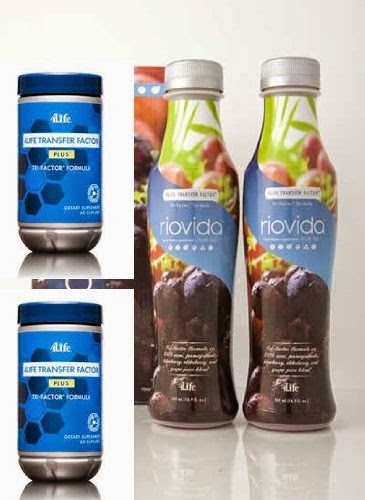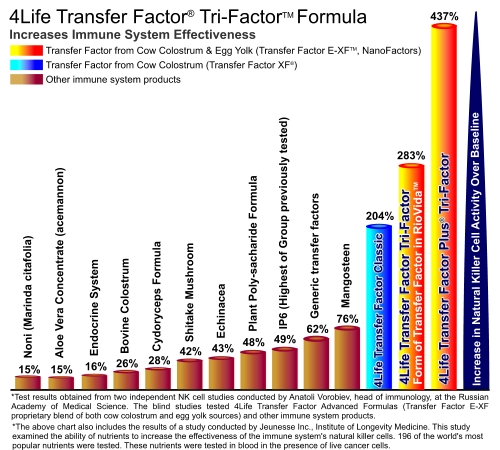
4Life Transfer Factor PLUS with Riovida Web Promotion
What is Transfer Factor?
Transfer factor, a factor derived from leukocyte lysates (white blood cell which have been undergone the destructive process of lysis) of immune donors, which can transfer both local, and systemic cellular immunity to non immune recipients. (NLM-MeSH) Transfer factor was first discovered by Henry Sherwood Lawrence, in 1955.
There is a possibility to transfer regularly immunologically specific, generalized skin sensitivity of the delayed type to tuberculin (a sterile solution extracted from tubercle bacillus which often used to diagnose tuberculosis) in animals, and human subjects, by means of an injection of leucocytes, obtain from sensitive donors. (Lawrence HS. 1955) Transfer factors can be extracted, either from human, or animal white blood cells, cow colostrum, and chicken egg yolk.
According to Kirkpatrick CH. 1993, transfer factors are molecules that educate
recipients to express cell mediated immunity, which have the effect of antigen specific. Transfer factors have molecular weights of approximately 5,000 Da, and offer molecular immunotherapy for patients with defective cell mediated immunity.
Transfer Factor Clinical Studies
A prospective, double blind placebo controlled trial was carried out on 29 hepatitis B patients. 13 patients received transfer factor, while 16 others received placebo. There were no significant differences between the two groups in any clinical, or laboratory measurements. Transfer factor did not alter the natural course of hepatitis B. (Ellis-Pegler R, et al. 1979)
A prospective randomized double blind study on 60 cervical cancer patients, after radical surgery and irradiation. Transfer factor preparations were collected from leukocyte donors of patients's husbands. 32 patients received transfer factor while the others received a placebo.
A patient died during the treatment with transfer factor. The cancer recurrence rate was five out of 31 transfer factor treated patients, and 11 out of 28 patients in the placebo group. (Wagner G, et al. 1983)
An open study of transfer factor on 470 multiple sclerosis patients, in New South Wales, confirmed the original observation that transfer factor, had some effect on slowing the course of multiple sclerosis. (Frith JA, et al. 1986)
Clinical trials of transfer factor in malignancy, lead to the conclusion, that transfer factor might not be an effective therapy for cancer. If it does, it may have a role in tumor therapy as an adjuvant (additional treatment, or therapy) to other forms of therapy, such as, surgery, irradiation, or chemotherapy. (Spitler LE, et al. 1987)
A double blind clinical trial of transfer factor vs. acyclovir was carried out on 28 patients with acute stage of herpes zoster. The transfer factor treated group was found to have more favorable clinical course than acyclovir. The study confirmed the immunomodulating properties of transfer factor. (Estrada-Parra S, et al. 1998)
4Life Transfer Factor

4Life Transfer Factor PLUS Tri-Factor Formula
A product of transfer factor supplement by 4Life Research L.C., direct selling, or MLM company that was founded by David and Bianca Lisonbee, in 1998. David Lisonbee had experienced 11 years in building his MLM business called Enrich International. After receiving the transfer factor extraction process patent from the U.S. Patent Office, David Lisonbee had made 4Life transfer factor, the only product available in the world.
All 4Life transfer factor products were derived from transfer factor of cow colostrum, or a transfer factor combination from cow colostrum, and egg yolk. Amazingly, after 15 years in the MLM industry, 4Life Research L.C. had gained $268 million revenues, in 2012, and ranked 45th largest global direct selling company, in 2013. (DSN Top 100)(archive)

Image is courtesy of professionalnetworkers.com.
In above chart, two independent blind studies claimed that 4Life Transfer Factor PLUS Tri-Factor Formula managed to increase in natural killer cell activity (immune system) up to 437%. But, I cannot find both studies were indexed at the U.S. National Library of Medicine, or PubMed.
I am not affiliate with 4Life, or even interest in becoming 4Life distributor. All products above are listed in Amazon.com, in which both of them are sold and shipped by different seller.
Although from Amazon's 4Life Transfer Factor PLUS Tri-Factor Formula verified purchased reviews, most customers are very helpful after consuming, I totally disagree with the chart above. Infact, from a brochure (written in English and Bahasa Indonesia) that I got couple of days ago, 4Life transfer factor is said to be:
900% stronger than other products in increasing immune system.
Moreover, the brochure is mentioned that, 4Life transfer factor is:
30 times stronger than ginseng, spirulina, royal jelly, chlorella, alfalfa, green tea, wheat grass, gingko, chloropyl, bee propolis, maca, grape seed, etc.
In the back side of the brochure is mentioned that:
Scientific abstracts of transfer factor can be read at PubMed:
http://www.ncbi.nlm.nih.gov/pubmed
PubMed contains biomedical literature from Medline, journal, and life science book via online. (the original text is in Bahasa Indonesia)
I laughed at myself while reading this. There are millions of scientific studies indexed in PubMed. And, I found zero result on clinical studies, which claimed the therapeutic effects of 4Life transfer factor, or the 437% stronger immune system.
I know that 4Life transfer factor may not be a scam, but, the brochure that I read, is a scam. However, for your own sake, whether 4Life transfer factor is a scam or not, the main thing is that, you should consult with your doctor before taking any 4Life transfer factor supplements, in order to give another suggestion, regarding to your medical records.
Below I quote some words from a debating post around the controversy about 4Life transfer factor as another MLM scam.
Testimonial evidence is NOT scientific evidence
Is colostrum from cows good for you? Yes, if you are a baby cow…..Transfer factor: another MLM scam
http://medicine.com.my/wp/?p=836 (archive).
After all, it's not the only product available in the world now!











.jpg)






